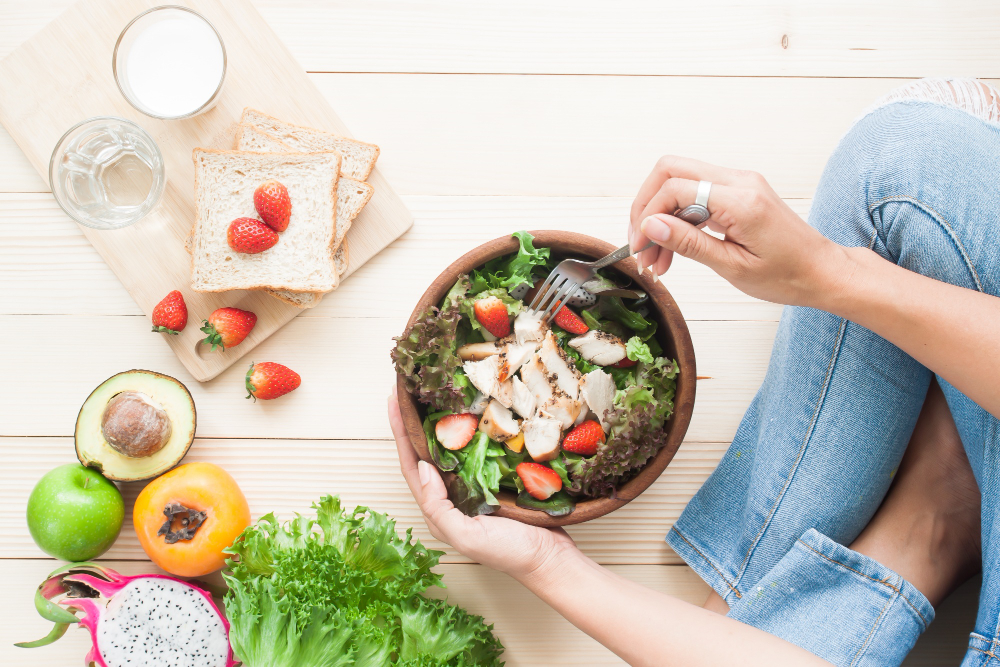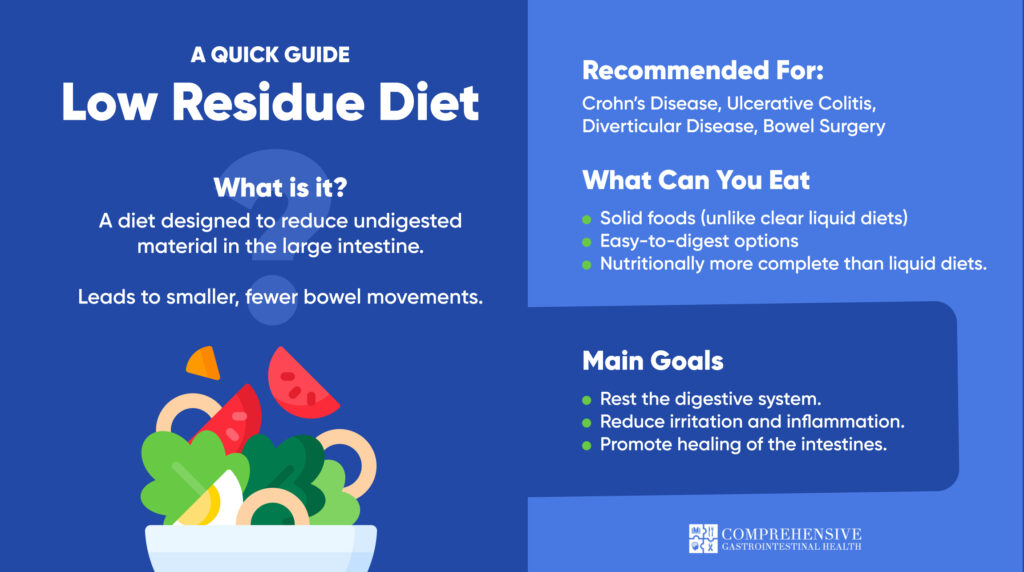Low Residue Diet—What Can You Eat?

Living with digestive challenges often means making thoughtful changes to what you eat. A low-residue diet simplifies mealtime by focusing on foods that are gentle on your digestive system while still being satisfying and nutritious. This specialized approach helps reduce bowel activity when you’re managing inflammatory bowel disease, preparing for a procedure, or recovering from surgery.
With the right information, you’ll find this temporary dietary adjustment offers plenty of delicious options rather than just restrictions.

What is a Low Residue Diet?
A low-residue diet is designed to reduce the amount of undigested material passing through your large intestine, resulting in smaller, fewer bowel movements. While often confused with a low fiber diet, a low residue diet goes beyond just restricting dietary fiber—it also limits foods containing other substances that may increase bowel activity.
Doctors typically recommend this approach for patients with conditions like Crohn’s disease, ulcerative colitis, diverticular disease, or those preparing for or recovering from bowel surgery. The goal is to give your digestive system a chance to rest and heal by minimizing irritation and inflammation.
Unlike a clear liquid diet, which is very restrictive, a low-residue diet allows you to enjoy many solid foods while still providing digestive relief. This makes it more sustainable and nutritionally complete for the short periods it’s typically prescribed.
Approved Foods for a Low Residue Diet
Dairy Products
Contrary to what some might expect, many dairy products are permitted on a low-residue diet. These include:
- Cheese (all varieties)
- Cream cheese
- Cottage cheese
- Yogurt (particularly vanilla)
- Milk
However, if you’re lactose intolerant, you may need to avoid milk products or choose lactose-free alternatives.
Protein Sources
Even on a low-residue diet, you can enjoy a variety of protein options to keep your meals satisfying. Eggs, chicken, turkey, pork (including bacon and sausage), lamb, fish, seafood (shrimp, lobster, scallops), and tofu are all excellent choices. Just remember to avoid tough, fibrous cuts of meat that might be harder on your digestive system—the goal is to choose proteins that are gentle on your body while still providing the nutrition you need.
Bread and Grains
When following a low-residue diet, focus on low-fiber grain options (less than 2 grams of fiber per serving):
- White bread or bagels (NOT whole grain breads or those containing seeds)
- White pasta (avoid whole grain varieties)
- White rice (instead of brown rice or wild rice)
- Low fiber cold cereals such as Rice Krispies, Corn Flakes, Rice Chex, and Special K
Fruits
You might be surprised by how many fruits you can still enjoy on a low-residue diet. Ripe avocados, bananas, cantaloupe, applesauce, and canned or peeled fruits without skin (pears, peaches, apricots) are all suitable options. Most fruit juices without pulp can also be included in your daily menu, though it’s best to avoid prune juice as it naturally stimulates bowel movements.
Vegetables
On a low-residue diet, raw vegetables are generally off-limits, but certain cooked vegetables are permitted:
- Cooked carrots
- Beets
- Pumpkin
- Asparagus
- Spinach
- Green beans
- Peeled potatoes (avoid potato skins)
- Mushrooms
You can juice vegetables as another way to incorporate their nutrients without the fiber.
Condiments and Cooking Additions
Several condiments can add flavor to your meals:
- Creamy peanut butter or almond butter (NOT crunchy varieties with pieces)
- Jelly (without chunks of fruit or seeds)
- Syrup
- Butter or margarine
- Vegetable oil or other oils
- Mayonnaise
- Sour cream
- Salt
- Plain mustard
- Soy sauce (in moderation)
Snacks and Desserts
You don’t have to forgo treats entirely:
- Pretzels
- Saltine crackers
- Animal crackers
- Vanilla wafers
- Graham crackers
- Ice cream
- Pudding
- Sherbet/sorbet (without pieces of fruit or seeds)
- Plain cakes and cookies made with white flour (no seeds, fruit, or nuts)
- Rice Krispies Treats

Sample Meal Ideas
A low-residue diet doesn’t have to be boring or flavorless. With some creativity, you can prepare delicious meals that keep your digestive system happy while satisfying your appetite.
Here are some practical options to consider as you plan your daily menu, whether you’re preparing for a procedure or managing a digestive condition.
Breakfast Options
- Hard-boiled or poached eggs with white toast
- Scrambled eggs or omelets with cheese
- Pancakes, waffles, or French toast (plain white, not whole wheat)
- White bagel with cream cheese or lox
- Breakfast sandwich with eggs, cheese, and a sausage patty
- Low-fiber cereal with milk
- Bacon or sausage with white toast
- Vanilla yogurt with honey
- Smoothie made with vanilla yogurt, creamy peanut butter, banana, milk, and honey
Fast food options like McDonald’s breakfast can work too—just avoid items with fruit, vegetables, or high-fiber ingredients.
Lunch and Dinner Ideas
Sandwiches
- Turkey, ham, chicken, bacon, or egg salad on white bread
- Cheese and mayonnaise are fine additions
- Skip the lettuce, tomatoes, onions, and pickles
- Creamy peanut butter and jelly (without seeds or fruit chunks) on white bread
Burgers
- Hamburger, turkey burger, or tofu burger on a white bun
- Cheese, mayonnaise, and plain mustard are acceptable
- Again, avoid lettuce, tomatoes, onions, or pickles
Pizza
- Topped with sausage, bacon, pepperoni, or chicken
- Cheese is OK
- Tomato paste or white base (avoid chunks of tomatoes)
Pasta Dishes (white pasta only)
- Pasta with chicken or shrimp, butter/olive oil, and parmesan cheese
- Macaroni and cheese
- Meat lasagna with garlic bread
- Smooth tomato sauce (no chunks, skin, or seeds)
- Creamy Alfredo sauce
Rice Dishes (white rice only)
- Rice with sausage (without vegetables or herbs)
- Shrimp fried rice with egg and soy sauce (no vegetables)
- Salmon with ginger rice and honey/soy sauce
Soups
- Chicken with noodles or white rice (without vegetables)
- Creamy soups without chunks (less than 2 grams of fiber per serving)
Foods to Avoid on a Low Residue Diet
To properly follow this fiber-restricted diet, you’ll need to avoid:
High-Fiber Grains
- Whole grain breads
- Brown rice
- Grain breads with seeds
- High-fiber cold cereals
Problematic Vegetables
- Raw vegetables of all kinds
- Brussels sprouts
- Lima beans, dried beans, and other legumes
- Turnip greens
- Sweet potatoes (unless peeled and well-cooked)
- Potato skins
Difficult-to-Digest Fruits
- Raw fruits with skins or seeds
- Dried fruits
- Berries
Other Items to Limit
- Seeds and nuts
- Tough meats
- Carbonated beverages (which can cause gas)
- Spicy foods
- Strong seasonings
Special Considerations
While following a low-residue diet is generally straightforward, there are a few special situations that require additional attention. These considerations will help you navigate specific circumstances and ensure you’re getting the most benefit from your dietary changes. Pay particular attention to these guidelines if you’re preparing for a medical procedure or following this diet for an extended period.
For Colonoscopy Preparation
If you’re preparing for a colonoscopy, you’ll need to be a bit stricter with your diet the day before. Skip all fruits and vegetables completely for your low-residue breakfast and lunch on that day, even the cooked ones that are normally allowed on the diet.
Nutritional Balance
This diet limits many high-fiber foods that provide important nutrients. Your doctor might suggest taking vitamin supplements while you’re following this eating plan to ensure you’re getting all the nutrition your body needs.
Hydration
Remember to drink plenty of fluids while on a low-residue diet to help prevent constipation. Water, clear broths, and approved fruit juices (without pulp) are all good choices to keep yourself well-hydrated.

When to Return to Normal Eating
A low-residue diet is typically not meant to be followed long-term. Your healthcare provider will advise you when it’s appropriate to gradually reintroduce higher-fiber foods into your diet.
For those with inflammatory bowel disease or diverticular disease, your doctor might recommend transitioning to a modified fiber intake based on your individual tolerance and symptoms.
Making the Most of Your Low-Residue Journey
A low-residue diet can be an effective tool for managing digestive conditions or preparing for medical procedures. By focusing on easy-to-digest foods and avoiding those that increase bowel activity, you can give your digestive system the break it needs while still maintaining adequate nutrition.
The food options we’ve covered offer plenty of variety to create satisfying meals during this temporary dietary adjustment. Remember to work closely with your healthcare provider to ensure you’re meeting your nutritional needs and following the appropriate timeline for your specific condition.
Everyone’s body responds differently to foods, so pay attention to how you react to different items on this list. Your gastroenterologist can help you fine-tune your diet based on your specific needs and symptoms, ensuring the best outcome from your low-residue regimen.
